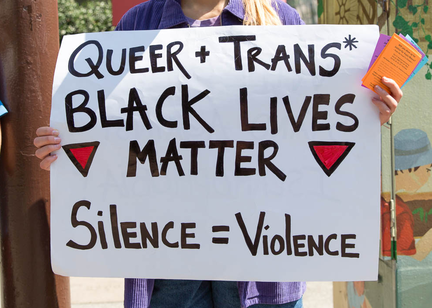|
By Sophia Friesen “To celebrate the cultures and diversity of the Lesbian, Gay, Bisexual, Transgender, and Queer (LGBTQ) community in Oakland and the East Bay”: this is the stated goal of Oakland Pride, celebrated on September 8th of this year. This is an admirable mission indeed, but was it achieved? Celebration of diversity is a vague goal: what it gains in breadth it loses in measurability. Who is truly included and celebrated as part of the East Bay LGBTQ community, and who is overlooked or left out?  Immersed in the crowd at the post-parade festival, it certainly appeared that folks from all walks of life were included. Whether bedecked in rainbows or in plain-colored street clothes, partygoers represented a multitude of ages, gender expressions, and racial identities. Indeed, according to the Oakland Pride website, two thirds of attendees were people of color. But the very structure of the festival obscures some harder-to-see differences. Notably, entering the festival requires payment of a $10 fee. For some folks this cost may be a drop in the bucket, but for others it’s prohibitively expensive. Similarly, the presence of police officers at the parade and festival is on its face intended to promote safety–but, in the context of local and national police violence against people of color, and especially trans people of color, the question must be asked: safety for whom? Let’s put this in a little context: For most of my time at Oakland Pride, I was sitting behind a table, under a small tent, next to a much larger and more elaborate tent run by supporters of a presidential candidate. I was there representing SURJ, and specifically trying to fundraise for two partner organizations: the Transgender, Gender Variant, and Intersex Justice Project (TGIJP), and Black Lives Matter. As a couple of white people sitting in front of a big TGIJP sign advertising, among other things, #BlackGirlMagic, my booth buddy and I attracted confused looks and interesting conversations alike. Although, more than once, someone who I thought was approaching our booth was instead heading to take a picture next to the life-size cardboard politician one booth over, what passers-by discussed with us highlighted some deep-seated inequalities that continue to permeate our queer community. For instance, one person came to talk to us about homelessness, and the issues specifically faced by trans people who are homeless. Having identifying documents that don’t match one’s name or gender can be exhausting, they explained, but especially when that identification is required to access basic needs like homeless shelters. And some shelters refuse (illegally) to accept trans people or respect their gender. When queer and trans people have more than double the risk of homelessness — and this risk is compounded for queer people of color — how can we better serve this part of the community? Probably not by holding a gated-off festival with an entrance fee. Another, older individual, in rainbow suspenders and button-studded shorts, passionately discussed with us racial disparities in the queer social scene. They’d been to a lot of queer clubs, they said, and the ones that catered to a more racially diverse population had fewer amenities and worse upkeep than ones with a primarily white clientele — even when the comparison was made between two establishments run by the same people. White supremacy pervades queer culture even in the supposedly enlightened Bay Area, and this spiritually impoverishes us all. As the poem goes, we need bread, but roses too. In a way, these issues can be summed up by a conversation that happened late in my shift, with a few young people who had recently started college in the Bay Area. When we asked what brought them to our booth, they pointed to the Black Lives Matter signs stacked at one corner of the table, and told us that they hadn’t seen any other organizations with the signs at the festival. This baffles me. How can we celebrate our queer culture and history without celebrating and centering the black trans women at the forefront of queer and trans rights movements? How can we blithely accept cops at Pride without acknowledging the historical, continual, and senseless police violence against queer and trans people of color? Overall, I personally believe that Oakland Pride does more good in the world than harm. It provides a venue to join together, to be passionately loud, to celebrate queer existence in the face of a world that too often tells us we should not exist. But this venue is only open to some. If it is to truly represent and celebrate our Bay Area queer population — and the legacy of queer struggle here and elsewhere, we should take heed of some of the organizations who are already leading the work. Luckily, we have plenty of role models right here in the Bay Area. Just for a few examples, the TGI Justice Project works to support incarcerated and formerly incarcerated trans women of color, fighting against the human rights violations that disproportionately affect this part of our community. TGIJP is based in San Francisco, as is El/La Para TransLatinas, which has worked for decades to advocate for translatina rights and foster a community of support. Oakland Pride promised to celebrate our “cultures and diversity”. But only by taking a page out of these organizations’ books, and welcoming the segments of the queer population it currently excludes, can we hope to fulfill that promise. Comments are closed.
|
Find articles
All
Browse by date
July 2024
MEDIUM |
© COPYRIGHT 2017-2024 SURJ BAY AREA. ALL RIGHTS RESERVED.


 RSS Feed
RSS Feed